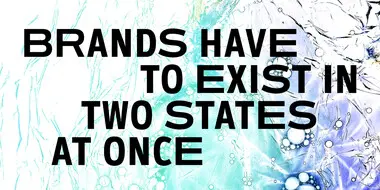Sustainability: a way forward for brands, a challenge for design.

Today, it is a moral imperative that companies and agencies prioritize sustainable, environmentally friendly principles and practices. More and more consumers are demanding that brands act responsibly when it comes to environmental concerns. But what role does visual communication play in this topic, and how can type and design contribute to good sustainability practices
Climate change is one of the fundamental challenges of our time. Almost all aspects of society are affected by it, including our consumer behaviour. People want environmentally friendly and socially responsible products at a fair price. If services can be handled digitally, such as banking transactions or reporting your electricity meter reading, consumers increasingly prefer to forgo traditional paper forms.
Nevertheless, this attitude is characterized by a persistent mind-behaviour gap—something that prevents a person’s will from becoming actual action. Most consumers care about protecting the environment, and most consumers also understand what they can do to help with those causes. But in the end, it is often the price of a product, convenience, or simply habit that dictates our choices.
So, what can brands do to connect with customers concerned about sustainability and help people change their behaviours in favor of more sustainable practices?
Finding a path forward.
Companies of all sizes are following the current debate closely. They see young people worldwide fighting for more climate protection in the streets or on the Internet. On the shelves of supermarkets, organic products and regionally produced goods are occupying more and more space. The tone of advertising is shifting toward morals and values.
Even governments are slowly realizing that many applications and forms can be processed digitally, without paperwork or in-person visits to government offices. With COVID-19, many consumers have discovered the advantages of contactless payment at the cash register. For them, paying with a smartphone or smartwatch is the safest method; for companies and banks, it means fewer cash transactions and reduced maintenance of ATMs. Anything companies can do to reduce our collective use of paper is a huge help to the environment.
A pioneer in sustainable banking is Trios Bank, a Dutch company that describes itself as “Europe‘s leading sustainability bank.” Since its founding in 1980, the bank has supported projects and companies with social, ecological, or cultural value. The bank’s balance sheet speaks for itself: The sustainability projects it has financed have resulted in a 962-kiloton reduction of CO₂ emissions.

The fact that the traditional automotive industry still has a lot of catching up to do was recently outlined by the Capgemini study “The Automotive Industry in the Era of Sustainability.” But companies like Tesla are demonstrating how automotive brands can design, advertise, and sell automobiles sustainably. The company’s Cybertruck is not only constructed sustainably—made of ultra-hard, cold-rolled stainless steel and bulletproof glass—but even the order page, designed in dark-mode, signals sustainability with short but precise texts.
With its “Move to Zero” campaign, Nike has set a goal of achieving “zero carbon and zero waste.” Its Nike Air VaporMax 2020 Flyknit training shoe, produced from residual materials, recycled polyester, and recycled foam and with a sole made of at least 75 percent recycled TPU (thermoplastic polyurethane), is a great example of how companies can reinvent themselves and their products to meet bold environmental objectives.
Nevertheless, product managers still ask themselves: What does sustainability mean for my business? Do I have to adapt my products and services? Is it even worthwhile for my brand to act sustainably? Is it perhaps just a fashion trend that we can ride out? The answers are: Everything! Yes! Absolutely! And, no, this is not a trend you can ignore.
From a business perspective, there are legitimate reasons to tackle the issue of sustainability now and communicate it openly. Because (some) politicians are finally taking this issue seriously, certain resources and methods are likely to become scarce, more expensive, or even unavailable in the near future. This will force even stubborn or slow-moving companies to act sustainably and adapt their processes.
Whether you’re an established brand or an agile newcomer, the time is now for brands to take a pioneering role in sustainability. There’s nowhere to hide in today’s socially connected world, and brands that hesitate risk being called out by consumers, environmental groups, and even some governments.

Make it easy to be an eco-champion.
The Sustainability Study by GIM Foresight, conducted online in February 2020 with 1,500 representatively selected consumers, found that people are intensely engaged in the topic of sustainability.
Around three-quarters are concerned about climate change, social injustice, or fear of having to change their current lifestyle. One-quarter of those surveyed believes that science and technology could solve many environmental problems. The study also suggests an explanation for the mind-behaviour gap by asking respondents what keeps them from buying sustainably. For 61 percent of those surveyed, it was the higher price, while 51% stated a lack of credibility, 32% needed more information, 24% did not have enough time to make a decision, and 16% were overwhelmed by the amount of information.
Of these responses, pricing is the only issue brands can solve immediately. To solve the rest, brands need to rely on their ability to communicate and connect with their customers. This is a challenge, to be sure, but an opportunity as well to build trust and loyalty with individuals looking for a brand they can believe in.
When brands do not communicate honestly and authentically, credibility can plummet quickly. And while whatever message you convey to the public needs to be backed up by your actions, credibility also has a lot to do with typography and design. Consumers feel the contradiction when a brand that describes itself as “progressive” communicates with a backward-looking typeface. Readers feel it, even if they cannot explain it. The same applies when a brand wants to appear objective and neutral but uses a highly stylized typeface that screams for attention or applause.

Visual design can also help give customers time to make an informed decision, which 24 percent of the respondents above said was a factor. Sometimes, this can be as simple as making an ingredient list easier to read—customers shouldn’t have to squint to make sure there’s nothing strange in their can of soup. But this can also extend to printing information clearly in different languages so customers of all backgrounds can inform themselves about your product. Plus, thoughtful visual design, and especially the use of clear, legible type, enables brands to drastically reduce their use of paper and packaging in favor of digital formats people can access through a mobile app or website.
Whatever the case, the decision to buy something shouldn’t feel like work or take too much of your customer’s time. Better design, legible fonts, and hierarchical typography can make that process simple and help customers feel confident about the product they’re purchasing.
Live your values behind the scenes.
COVID-19 has shown us that many office tasks can be handled digitally from people’s home and other remote locations. Communication via video conferencing can replace flights and rail travel. Training and further education courses can also be conducted on-screen. There are a lot of benefits to working this way, not the least of which is environmental. Working from the home office one or two days a week reduces commuting time and the carbon footprint associated with people driving into work.
No surprise, then, that many companies have already determined they won’t return to a mandatory in-office policy once the pandemic ends. Cloud-based software solutions help create manuscripts, presentations, advertisements, flyers, and digital documents. At the same time, programs like Monotype Fonts allow teams to store, share, and manage important brand assets from anywhere in the world. Giving employees the choice to work from home is one way to prioritize the environment—along with your employees’ well-being, of course—over the old status quo.
Climate change is one of the fundamental challenges of our time. Almost all aspects of society are affected by it, including our consumer behaviour. People want environmentally friendly and socially responsible products at a fair price. If services can be handled digitally, such as banking transactions or reporting your electricity meter reading, consumers increasingly prefer to forgo traditional paper forms.
Nevertheless, this attitude is characterized by a persistent mind-behaviour gap—something that prevents a person’s will from becoming actual action. Most consumers care about protecting the environment, and most consumers also understand what they can do to help with those causes. But in the end, it is often the price of a product, convenience, or simply habit that dictates our choices.
So to recap:
- Build sustainability into your products themselves, so it’s easy for customers to recognize your commitment and make the change to more environmentally friendly products and practices.
- Make it simple for customers to make informed decisions about your products through the thoughtful use of typography and visual design in your packaging and communications.
- Reduce or eliminate your reliance on printed information, using typography, visual, and UX design to create digital forms and deliver a painless online user experience.
- Live your values by reducing your use of paper in the office, implementing cloud-based software programs that connect teams worldwide, and empowering people to work remotely and reduce their personal carbon footprint.














